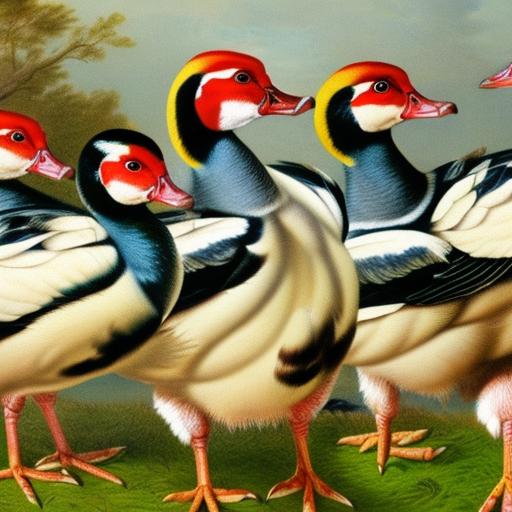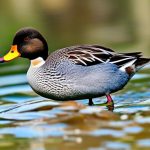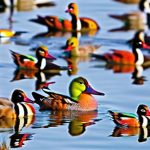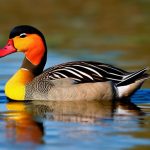Muscovy ducks, also known as Cairina moschata, are a unique breed of duck that is native to Mexico, Central, and South America. They are a large breed of duck, with males weighing up to 15 pounds and females weighing up to 8 pounds. Muscovy ducks are known for their distinctive appearance, with a red, warty face and a crest of feathers on their heads. They come in a variety of colors, including black, white, and blue, and are often raised for their meat and eggs. Muscovy ducks are also popular for their ability to control pests, as they are excellent foragers and will eat insects, slugs, and other small creatures. They are also known for their calm and friendly demeanor, making them popular pets and additions to backyard flocks.
Muscovy ducks are unique in that they are not as closely related to other duck breeds as they are to geese. They are the only domesticated duck breed that is not descended from the mallard. This makes them a distinct and interesting breed to raise and study. Muscovy ducks are also known for their ability to fly, unlike many other domesticated duck breeds. This makes them more independent and less likely to wander off than other ducks. Overall, Muscovy ducks are a fascinating and versatile breed that has been domesticated for thousands of years.
Key Takeaways
- Muscovy ducks are a unique breed known for their large size, quiet nature, and ability to fly.
- Muscovy ducks reach sexual maturity at around 5-6 months of age, with males displaying more aggressive behavior during this time.
- Breeding season for Muscovy ducks typically occurs in the spring and summer months, with females laying eggs in secluded areas.
- Courtship behavior of Muscovy ducks involves males displaying and vocalizing to attract females, often leading to aggressive interactions between males.
- Muscovy ducks build their nests in tree cavities, on the ground, or in man-made structures, and females lay a clutch of 8-16 eggs.
Sexual Maturity of Muscovy Ducks
Muscovy ducks reach sexual maturity at different ages depending on their gender. Female Muscovy ducks typically reach sexual maturity at around 5-6 months of age, while males may take a bit longer, reaching sexual maturity at around 7-8 months of age. This means that Muscovy ducks can start breeding relatively early compared to other duck breeds. It’s important to note that while Muscovy ducks may reach sexual maturity at these ages, it’s best to wait until they are fully grown before allowing them to breed. This ensures that they are physically mature enough to handle the demands of breeding and raising ducklings.
Sexual maturity in Muscovy ducks is often signaled by changes in behavior. Males may become more aggressive and territorial as they reach sexual maturity, while females may start exhibiting nesting behaviors. It’s important for duck owners to be aware of these changes and be prepared to provide appropriate housing and care for breeding Muscovy ducks. Overall, understanding the sexual maturity of Muscovy ducks is important for successful breeding and raising of healthy ducklings.
Breeding Season for Muscovy Ducks
Muscovy ducks are known for their year-round breeding capabilities, but they do have a peak breeding season that typically occurs in the spring and summer months. During this time, Muscovy ducks are more likely to engage in courtship behaviors and nesting activities. The longer daylight hours and warmer temperatures during the spring and summer months trigger hormonal changes in Muscovy ducks, signaling that it’s time to breed. This is also the time when food sources are more abundant, providing the necessary nutrients for successful breeding and raising of ducklings.
While Muscovy ducks may breed year-round, it’s important for duck owners to be aware of the peak breeding season and be prepared to provide appropriate housing and care for breeding pairs. This includes providing nesting boxes or areas for females to lay their eggs, as well as ensuring that males have enough space to display courtship behaviors without becoming aggressive towards other ducks. Understanding the breeding season for Muscovy ducks is crucial for successful breeding and raising of healthy ducklings.
Courtship Behavior of Muscovy Ducks
During the breeding season, male Muscovy ducks will engage in elaborate courtship displays to attract females. These displays often involve puffing up their feathers, wagging their tails, and making low, rumbling calls to the females. Males may also perform a “head-pumping” display where they rapidly move their heads up and down while making a soft cooing sound. These courtship displays are meant to impress the females and demonstrate the male’s fitness as a potential mate.
Female Muscovy ducks will also engage in courtship behaviors by showing interest in the males’ displays and vocalizations. They may also perform a “nest scrape” display where they dig a shallow depression in the ground or nesting material as a signal to the male that they are ready to mate. Once a pair has formed, they will often engage in preening each other’s feathers and staying close together as they prepare to mate.
Understanding the courtship behavior of Muscovy ducks is important for duck owners who are breeding these ducks. Providing a suitable environment for courtship displays and ensuring that males have enough space to perform these displays without becoming aggressive towards other ducks is crucial for successful breeding.
Nesting and Egg-laying of Muscovy Ducks
Once a pair of Muscovy ducks has formed during the breeding season, the female will begin searching for a suitable nesting site. Muscovy ducks prefer to nest in secluded areas such as hollow trees, brush piles, or nesting boxes provided by duck owners. The female will line the nest with down feathers from her own body to create a soft and warm environment for her eggs.
Female Muscovy ducks typically lay one egg per day until they have laid a full clutch of eggs, which can range from 8-16 eggs depending on the individual duck. Once the full clutch is laid, the female will begin incubating the eggs by sitting on them to keep them warm and protected. It’s important for duck owners to provide a quiet and secure nesting area for the female during this time to ensure that she feels safe and comfortable while incubating her eggs.
Understanding the nesting and egg-laying behavior of Muscovy ducks is crucial for successful breeding and hatching of ducklings. Providing suitable nesting areas and ensuring that females have access to enough nesting material is important for encouraging healthy egg-laying behavior.
Incubation and Hatching of Muscovy Duck Eggs
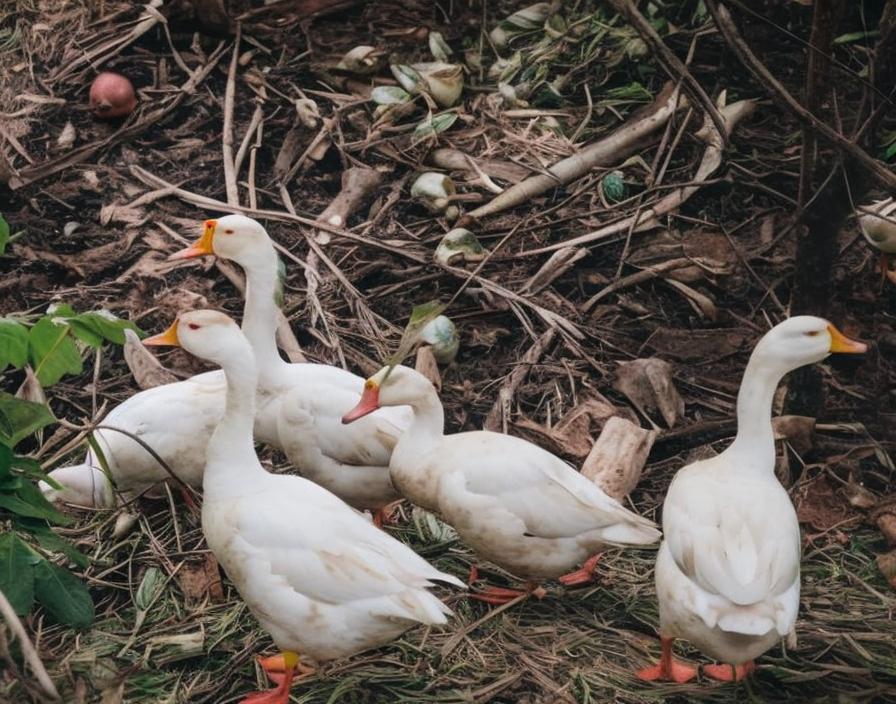
After the female Muscovy duck has laid her full clutch of eggs, she will begin incubating them by sitting on the eggs to keep them warm and protected. The incubation period for Muscovy duck eggs is approximately 35 days, during which time the female will rarely leave the nest except to eat, drink, and bathe. It’s important for duck owners to provide easy access to food and water for the incubating female to ensure that she stays healthy during this time.
As the incubation period nears its end, the eggs will start to hatch, with the ducklings breaking through the shells using their egg tooth—a small projection on their beak that helps them crack the shell. Once the ducklings have hatched, the female will lead them out of the nest to find food and water. It’s important for duck owners to provide a safe and secure environment for the mother and her ducklings during this time to ensure their safety and well-being.
Understanding the incubation and hatching process of Muscovy duck eggs is crucial for successful breeding and raising of healthy ducklings. Providing appropriate care and support for the incubating female and her ducklings is important for ensuring their survival.
Conclusion and Conservation Efforts for Muscovy Ducks
In conclusion, Muscovy ducks are a unique and versatile breed that is known for their distinctive appearance, calm demeanor, and excellent foraging abilities. Understanding their sexual maturity, breeding season, courtship behavior, nesting and egg-laying habits, as well as incubation and hatching process is crucial for successful breeding and raising of healthy ducklings.
Conservation efforts for Muscovy ducks are important for preserving this unique breed for future generations. While Muscovy ducks are not currently considered endangered, their wild populations are at risk due to habitat loss and hunting pressures. It’s important for conservation organizations and duck enthusiasts to work together to protect wild populations of Muscovy ducks through habitat preservation, captive breeding programs, and education efforts.
Overall, Muscovy ducks are a fascinating breed with a rich history and unique characteristics that make them a valuable addition to any flock or conservation program. By understanding their behavior and needs, we can ensure that Muscovy ducks continue to thrive for years to come.
If you’re considering breeding ducks, it’s important to understand their mating season. According to a helpful article on PoultryWizard.com, “When is Duck Mating Season,” muscovy ducks typically start breeding in the spring. This information can be crucial for anyone looking to raise ducks for meat or eggs. For more insights on poultry care and housing, check out their article on the Producers Pride Sentinel Chicken Coop here.
FAQs
What is the breeding season for Muscovy ducks?
Muscovy ducks typically start breeding in late winter or early spring, with the exact timing varying depending on the location and climate.
At what age do Muscovy ducks start breeding?
Muscovy ducks generally reach sexual maturity and start breeding at around 5-6 months of age.
How can you tell if a Muscovy duck is ready to breed?
Muscovy ducks that are ready to breed will exhibit specific behaviors such as courtship displays, mating rituals, and the formation of pairs.
How long does the breeding season last for Muscovy ducks?
The breeding season for Muscovy ducks typically lasts for several months, with peak breeding activity occurring in the early spring and tapering off as the season progresses.
Do Muscovy ducks breed every year?
Muscovy ducks are known to breed annually, with the breeding season typically occurring once a year. However, some ducks may breed more than once in a year under certain conditions.
Meet Walter, the feathered-friend fanatic of Florida! Nestled in the sunshine state, Walter struts through life with his feathered companions, clucking his way to happiness. With a coop that’s fancier than a five-star hotel, he’s the Don Juan of the chicken world. When he’s not teaching his hens to do the cha-cha, you’ll find him in a heated debate with his prized rooster, Sir Clucks-a-Lot. Walter’s poultry passion is no yolk; he’s the sunny-side-up guy you never knew you needed in your flock of friends!

